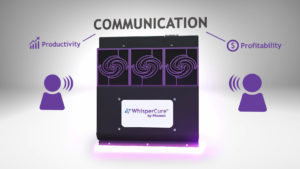When it comes to label and packaging solutions, Phoseon Technology has the (LED) cure. Phoseon’s UV LED (light emitting diodes) curing products are currently being utilized in the printing, coating and adhesive industries, and the technologies are available to clients in custom configurations.
According to Phoseon, the company is 100% focused on LED technology–providing rugged, high-performance products for application specific solutions. Phoseon’s patented Semiconductor Light Matrix (SLM) technology encapsulates LEDs, arrays, optics and thermal management to ensure curing performance. Each of these four components is a strictly engineered system that provides maximum UV energy and superior performance while also increasing long-term robustness for demanding applications.
“UV LED curing technology has arrived. It is no longer an emerging technology but an enabling technology− one that is bringing a host of advanced capabilities to screen printing, flexographic and digital printing. These advances and new capabilities are helping industrial, graphics and specialty printing operations be more productive, versatile and energy efficient.”
Phoseon technology
While arc and microwave curing technologies rely on the vaporization of mercury within a sealed quartz tube containing an inert gas mixture, LEDs are solid-state semiconductors. They contain no moving parts or mercury plasma gas and operate at temperatures that are often less than 1/10 the operating temperatures of conventional lamps. When connected to a DC power source, an electric current flows through the semiconductors, dropping electrons into a state of lower energy as they travel from the negative to the positive side of each discrete LED. The energy differential is released from the device in the form of a relatively monochromatic spectral distribution.
Phoseon provides products for commercial and industrial applications. These products utilize 365nm, 385nm, 395nm, and 405nm wavelengths and offer product families with both air-cooled and water-cooled UV curing systems.
Commercially, UV LED technology has significant market adoption with longer UVA wavelengths (365, 385, 395 and 405 nm), and development work in shorter UVB and UVC bands continues, says Phoseon.
Even though there is no UV LED source that is directly comparable to a conventional lamp, the longer wavelengths emitted by LEDs offer spectral distribution more similar to an iron or gallium lamp than a basic mercury lamp. Therefore, UV LED wavelengths can penetrate deeper into the chemistry and produce better through-cure, particularly with opaque and pigmented formulations.
Phoseon began using LED technology for UV curing applications in 2002, and the company currently has over 250 patents and trademarks. In 2006, not many ink were compatible with UV LED technology. Today, most ink manufacturers and material vendors are capable of supporting LED technology.
New resins, monomers, oligomers and photo-initiators have been under development. UV LED flexo inks have been formulated with UV LED lamps to offer a viable solution for flexo printing. As the number of ink and commensurate resin, polymer, and photoinitiator supplier increases, the industry continues to come up with new innovative ways to use UV LEDs, says Phoseon.
Phoseon describes UV LED curing sources as “high-tech electronics,” so the technology has blossomed with that of smartphones, laptops, tablets and televisions. During the technological boom, which has occurred between 2010 and 2017, UV LED sources have become more powerful, more efficient, more reliable and less expensive.
“UV LED curing technology has arrived,” the company says. “It is no longer an emerging technology but an enabling technology− one that is bringing a host of advanced capabilities to screen printing, flexographic and digital printing. These advances and new capabilities are helping industrial, graphics and specialty printing operations be more productive, versatile and energy efficient.”
Tags: UV LED Curing for Printing Applications | Label & Narrow Web Magazine | UV LED Curing SystemsCategories: Adhesives | Chemistry | Coatings | Inks | Printing, Digital | Printing, Flexo
